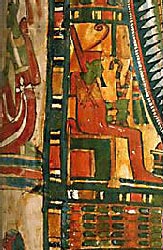- Isis was a very important figure in Egyptian mythology. She was known to the Egyptian people as a healer, magician, and exemplary
wife and mother.
What details of this sculpture show us that Isis is an important person?
Crown or tall hat identifies rulers, deities, and/or important members of a community in many cultures.
- An ATTRIBUTE
is a distinctive symbolic feature that identifies a character. Identify Isis's
attributes: a serpent (left hand), a vulture (wrapped around the base of Isis's crown), a jug of water (right hand).
What is an AMULET?
An object or charm, usually worn as jewelry.
Look for the amulet Isis wears around her neck (the Isis-knot, a fertility symbol).
 |
Painting of Osiris from the Mummy Case of Lady Teshat |
- Compare with the painting of Osiris (image 1). Both of these works of art are Egyptian, but their overall STYLES or design
qualities are different. Describe the stylistic differences between Osiris and Isis. Consider: facial features, treatment of bodies
and garments, and media. (Osiris's face, shown in profile, is consistent with Egyptian formulas for representing people. Isis has
natural features more consistent with portraiture and meant to be seen from many sides. Isis's body is a
THREE-DIMENSIONAL
sculpture with rounded forms, Osiris's body is a
TWO-DIMENSIONAL
painting with flat, straight outlines and angles. Isis's garments have
NATURALISTIC
and descriptive folds, Osiris's mummy garment has no folds or descriptive elements.
The artist who painted Osiris used color, the artist who sculpted Isis did not.)
Think
- Isis tricked Ra into revealing his secret name so that she could have Ra's power.
Think about Isis' attributes and their symbolic meanings-what do you think she did with that power?
Dart-shaped serpent a reference to the power Isis gained from Ra, vulture on crown symbolizes protective powers, Tyt
AMULET
a reference to her life-giving powers.
See also Story section of Osiris, image
- Isis was a superhero to the ancient Egyptian people. A superhero is a hero who takes human form but possesses supernatural
powers. Can you think of any women who are superheroes today? (Wonder Woman, Xena Warrior Princess, Buffy the Vampire Slayer,
X-Men's Storm, Jean Grey and Rogue, the Power Puff Girls, Dark Angel, and Tomb Raider's Lara Croft.)
- Egyptian works of art you have studied in the World Mythology in Art image set all include
ATTRIBUTE
of the gods they represent. Review
Osiris,
Thoth, and
Isis.
Why did the Egyptian artists use attributes when they depicted these gods?
To identify the gods.
|











